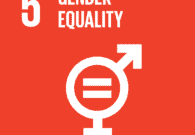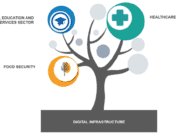India’s socio-economic priorities
India’s path to development is aligned with the UN’s Sustainable Development Goals – 17 goals that form the blueprint for a prosperous and sustainable future.
As one of the world’s great geopolitical powers, India has played a leading role in the formation of the goals. Accordingly, there has been a renewed push by the Indian Government on socio-economic programmes aimed at reviving jobs, investments, exports, enhancing delivery of healthcare, housing and water for all, infrastructure development and supporting the agricultural sector.
The Indian Government under Prime Minister Modi has placed particular emphasis on several of the SDGs, including:
SDG 1: No Poverty
Eliminating poverty lies at the core of India’s national development agenda. Maintaining a high average annual GDP growth rate and developing industry are critical to create the remunerative jobs needed to absorb and benefit from India’s growing labour force. Additionally, there are targeted programmes to improve the income levels of the economically disadvantaged by developing agriculture infrastructure and support services, skills and entrepreneurship. Social protection measures are also growing to mitigate risks from natural and other disasters.
Programmes are being implemented for ensuring access to education, health and nutrition security, drinking water and sanitation, with a focus on vulnerable groups such as women and children.
SDG 2: Zero Hunger
Innovative initiatives are being introduced to modernise agriculture in order to generate more produce and reduce the negative impacts of climate change. Access to subsidised food has been made an entitlement and improvement of the public distribution system enables increasing access to food grains. Initiatives include the Public Distribution System, which provides food grains at affordable prices to more than 800 million people. The Mid-Day-Meal Programme provides meals to 100 million children in primary schools. Additionally, food distribution governance is being strengthened through the digitisation of ration cards and an online grievance redressal mechanism.
SDG 3: Good Health and Well-Being
Emphasis on water and sanitation has had a considerable impact on the spread of communicable diseases. Focus on preventative care has increased, helping to lower the strain on India’s health services which struggle to keep up with the demands of India’s growing population. The attack on malnutrition has become comprehensive through increasing the entitlement to food under the National Food Security Act and the well-targeted National Nutrition Mission and Poshan Abhiyaan.
Technology is leveraged for improving the efficiency of the health management system, including the use of Artificial Intelligence to improve diagnostics and treatment. Additionally, there are significant efforts and initiatives to improve government accountability on health. For instance, the government has committed to enhancing public health expenditure to 2.5 per cent of GDP by 2025.
SDG 5: Gender Equality
Initiatives to eliminate poverty must also address issues of women in poverty and their access to economic assets, financial services, social protection, and opportunities for skill development and employment. This includes efforts to ensure access to essential services and facilitate equality of opportunity. Legislation has been put in place to make women leaders and stakeholders in equal measure in all walks of development of the country. Government schemes such as Beti Bachao, Beti Padhao and Sukanya Samridhi Yojana schemes, among others and mandatory maternity leave rules are making some progress.
SDG 9: Industry, Innovation and Infrastructure
To attain these goals, India must continue to develop industry, provide infrastructure and produce resources for its population to benefit from and contribute to. Major structural reforms include the implementation of the Goods & Services Tax (GST), FDI regime liberalisation, Ease of Doing Business Reforms and introduction of the Insolvency and Bankruptcy Code to work towards these purposes and promote investment and foster innovation. There is emphasis on the digital revolution, internet penetration and financial inclusion. Flagship programmes like Make in India, Startup India, and Skill India form the framework of India’s growth plans. These reforms are creating a highly conducive ecosystem accelerating the growth of innovation, entrepreneurship and business within a fast-growing formal economy.
UK companies are already contributing to these and other goals in India. The UKIBC is collating case studies of UK companies supporting India’s endeavours towards the SDGs. If your company would like to feature on the UKIBC SEI website, contact kealan.finnegan@ukibc.com with information on the work that your company is doing to support socio-economic development in India.
In the next blog, I will outline some of the challenges India faces in achieving these goals, simultaneously presenting areas where the UK and international business can support.
For more information on India’s commitment to the SDGs, see the full SDG India Index report produced by NITI Aayog https://niti.gov.in/overview-sustainable-development-goals

 By Kealan Finnegan
By Kealan Finnegan 




